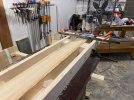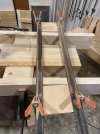Situation: Workbench top laminations shifted 1/8”-1/4” up/down during glue up (each glue up is six boards 8ft long, ~5” wide, 1 1/4” thick)
Have been trying to hand plane it to flattish, but geez the time, energy, and re-squaring and flattening is taking a lifetime. There has to be a better way outside of buying a freestanding jointer and don’t have a vehicle appropriate for lugging them over to NCstate wood studio.
I bought a wen electric planer, but the bed/shoe (or whatever its called) is out of alignment when set at zero w/no obvious way to readjust.
Very open to ideas.
Much appreciated!
Have been trying to hand plane it to flattish, but geez the time, energy, and re-squaring and flattening is taking a lifetime. There has to be a better way outside of buying a freestanding jointer and don’t have a vehicle appropriate for lugging them over to NCstate wood studio.
I bought a wen electric planer, but the bed/shoe (or whatever its called) is out of alignment when set at zero w/no obvious way to readjust.
Very open to ideas.
Much appreciated!


